
It was worth the wait.
From a historical sense, it’s the icing on a figurative cake for a landmark year in which the iconic food packager celebrates founder George A. Hormel’s 150th birthday.
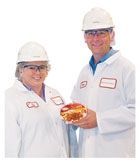
Plant manager Mark Zelle along with production
superintendent Kari Pollak show off the main reason this 348,000-square-foot
plant was built: a 10-ounce sleeved tray of shelf-stable, microwavable Compleats meals.
And, last but not least, the 348,000-square-foot building is sustainable. From sensor-activated skylights that adjust plant lighting to the water collection and reuse systems, it’s nearly as green as the corn growing in the surrounding countryside. Validation came in July when the plant received prestigious Leadership in Energy and Environmental Design (LEED) Gold recognition by the U.S. Green Building Council. LEED provides independent, third-party verification that a building project meets the highest green building and performance measures.
“Progressive Processing is a result of our continued growth,” says Jeffrey Ettinger, chairman of the board, president and chief executive officer at Hormel Foods. “It incorporates some of the latest technology available for manufacturing.”
At the heart of this plant located in the heart of the country is a state-of-the-art packaging production line for a quintessential prepared, packaged food: shelf-stable Compleats microwavable meals.
“This line is a showcase because not only is it new, it’s situated in a very sustainable plant that has been designed for years of use well into the future,” says plant manager Mark Zelle. “We have taken all of our best engineering and established a building block for the future.”
The building block also provides Hormel a firmer foundation in the shelf-stable foods category. “This line indicates our commitment to the microwavable convenience package,” says Zelle. “Consumers are looking for more than a canned food. They’re looking for something that they can take to work and keep in a desk drawer.”
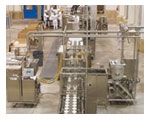
An overview of the 140-foot-long primary packaging portion of Compleats production/
A Compleats change in plans
The original plan was for the Dubuque facility to operate four Compleats production lines, each running at 180 trays per minute.“The thought process at the time was that not only did we need a new Compleats plant, we needed a facility that had additional capacities,” says Zelle. “Real estate in our plants was at a premium.”
But when the economy soured, plans changed for Hormel as they have for numerous packagers; the company both scaled back and scaled up to one line running at rates to 240 trays per minute. That makes this the fastest of five Compleats lines scattered around the country, with the others located at three other plants.
Officially started up on Jan. 25 (the first product run was spaghetti), the line was packaging Swedish meatballs at that target rate on the day of our summertime visit.
As a thirty-year, two-plant Hormel employee and a former quality control manager, Zelle is a stickler for product quality that’s driven by two aspects: food safety and personal safety.
“If we’re covering those two things, we’re doing a good job,” he says.
The shiny, stainless-steel machines on the plant floor reflect food safety concerns literally and figuratively, starting with the 140-foot-long tray dispensing, filling, and sealing operation supplied by Raque Filling Systems. It runs nearly the entire length of the spacious primary packaging area.
Provided as a turnkey system, the system was engineered for gentle container handling. Servo motors were used throughout the system, which makes adjustments much easier through the operator control panel.
With rare exception, the line fills 10-ounce oval polypropylene barrier trays from Rexam that boast a source-reduced lidstock (see sidebar p. 22). However, the tray itself may be changed in the future with a line extension or two, as the company is also considering a 7-ounce size as well as a segmented tray, Zelle discloses. He believes a future opportunity for Hormel and for the plant may be meals tailored to breakfast occasions and to children.
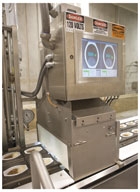
As with this post-filling X-ray inspection system, the
machines on the line fit in seamlessly with the plant’s emphasis on food safety
and quality.
Tray filling
Tray flow is divided into two lanes upstream of filling. Non-pumpable ingredients are added in-line by a pair of 24-head computerized combination weighers from Multipond America Inc. Trays next convey for four-at-a-time product depositing via piston pumps as the trays move in tandem beneath the traveling carriage assembly; it’s one of three such carriages on the system that interface the moving trays with a filling operation.An oscillating “meat tamper” device is activated for some products to keep the package contents below the container flange level before sealing.
As challenging as it is crucial, sealing is done eight trays at a time in each of two parallel lanes. The trays’ headspace receives a gas flush during sealing.
To help maintain sanitation and reduced related stoppages, the system uses Raque’s continuous chain washer that also helps keep the tray bottoms clean.
“Raque was very strong as far as training,” notes Zelle. Raque and other key vendors were called on for additional training as personnel became more experienced with the equipment, he adds.
The trays are inspected automatically in two quality assurance steps. Before sealing, the filled trays are checked by a Safeline X-ray inspection system from Mettler Toledo and, after sealing, are checkweighed by a Mettler Toledo Hi-Speed system.
The sealed trays are then conveyed out of the primary packaging room to a separate, more cavernous production area. First up is a Dynac Model 6400 accumulation system from Hartness Int’l, which is part of Illinois Tool Works (ITW). The space-saving, zero-pressure accumulator provides a buffer to the product flow into the Aagard retort loader and stack turner. Other machinery in this area supplied by Aagard Group include a retort unloader and stack turner, a wraparound sleever, a wraparound case packer, and a compact palletizer. As with Raque, Hormel’s reliance on Aagard also reflected prior experience and confidence in its management and its expertise in pick-and-place product handling operations, according to Zelle.
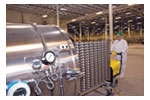
With the sleeving operations visible in the distance of this
sprawling plant, an operator removes the racks of inverted trays from one of
the 12 retorts. The plant permits much room for future expansion.
Robotic assist
The retort loader removes trays from the infeed conveyor, and collates and loads them in seven rows of eight trays placed into carts designed to be placed in the retort. Two pick-and-place robots-a two-axis and a three-axis unit-handle the trays and stacks. A completed stack holds 1,056 trays. The loads are inverted by a stack turner ahead of retorting, because retorting the trays bottom side up enhances the products’ aesthetics when a consumer opens the package.Between the Aagard loader and unloader are 12 Allpax retort units. The retort cycle is approximately 2½ hours, depending on product. In one of the many aspects of the LEED-level plant, exhaust from the plant boilers is used to preheat the water used in the retorts. If production demands increase, there is room for 12 more retorts, Zelle notes.
After retorting, the retort cart is turned right-side-up by the stack turner and conveyed to the unloader. This operation basically reverses the process of the loader by removing the trays from the stacks and places them in single file, using a tandem of two-axis and three-axis robots. The trays convey to an Aagard combination wraparound servo sleever. The operation involves a two-axis servo inverting placer and another three-axis pick-and-place robot.
Wrapped in a colorful printed paperboard sleeve, the trays are conveyed to a harness-style wraparound case packer. It collates the sleeved trays into groups that are pushed six at a time into U-shape corrugated blanks that are glued, compressed, sealed and indexed. A compact Aagard palletizer uses a two-axis robot to pick and place the six-count cases to create 200-case unit loads. In the final packaging production step, the pallets are unitized by a Lantech stretch wrapper for warehousing and distribution.
Important as the energy-saving aspects of the plant are, Zelle feels that the facility also energizes the company’s production flexibility.
“What this building provides is the capacity to try different things, whether those are going to be singles or home runs,” he concludes.
With the Field of Dreams movie baseball field carved out of a cornfield located about 25 miles from the plant, his analogy is particularly apt. With this plant, Hormel has established a home field advantage in microwavable, convenience foods for years to come. F&BP
FOR MORE INFORMATION:
The Aagard Group, LLC
320-763-6043; www.aagard.com
Allpax Products, LLC
888-893-9277; www.allpax.com
Hartness Int’l.
800-845-8791; www.hartness.com
Mettler Toledo
800-836-0836;www.mt.com
Multipond America Inc.
920-490-8249; www.multipond.com
Raque Food Systems, LLC
502-267-9641; www.raque.com
Rexam
636-825-8905;www.rexam.com
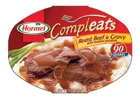
The latest sustainability gain on the brand is a 25% source
reduction on the lidstock that saves nearly half a million pounds of packaging
a year.
SIDEBAR: The Compleats packaging weight-loss program
Like the Dubuque plant where it’s manufactured, Compleats packaging offers sustainable features, too.The initial “greening” of Compleats packaging was set in motion with material reductions in 2003 when the products moved from a carton to a paperboard sleeve. The change was a success for two key reasons, explains Hormel Foods’ Dan Miller.
“For sustainability, it was a smart idea, but really, the whole thrust of pushing forward in this direction was that we wanted consumers to know what they were buying,” he says. “We really felt that something was being missed by consumers by placing the tray into a carton.”
Based on 2005-2006 paperboard tonnage, Hormel calculates that change alone represented a savings of 4 million pounds of packaging yearly.
The response from consumers was highly favorable, Miller reports: “We feel that a lot of the growth that has led to four facilities producing Compleats can be attributed to that one change.”
In 2008, Compleats moved from a UV-coated paperboard to an aqueous coating, a move that Hormel calculates saves 250,000 pounds of material yearly.
Around the same time, Hormel also honed in on the tertiary packaging as another opportunity for sustainable gains and packaging reductions. Based on “what if” scenarios and using an improved case design, the Hormel packaging team was able to reduce the amount of corrugated used for the six-count cases by 23%. The change, transparent to the packaging equipment, saves roughly a million pounds of corrugated a year, Miller says. And, he points out, the corrugated board is made of 100% post-consumer recycled content, a conversion that was made in the early 2000s.
Reaching that amount of savings reflects more than a design and material change: Hormel also altered its palletizing operations and bettered its best practices in how it shipped the cases. This includes a pallet pattern that Miller characterizes as “complicated.”
In 2008, Hormel began to focus its attention on source-reducing the barrier lidding for the trays. The full conversion from a five-ply structure to the new three-ply structure, which sheds 25% of the lidstock, will be realized in 2010. “We optimized the lidstock material using new technology,” is about as much as Miller will disclose.
However, the result is far more tangible: A 460,000-pound yearly savings in packaging materials.
Staying lean and green fits perfectly into Hormel’s ongoing packaging plans.
